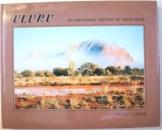AustLit
Latest Issues
AbstractHistoryArchive Description
'This well-presented history of Uluru, the major centre of Aboriginal dreaming tracks, Begins with the traditional lives of the Yankuntjatjara and Pitjantjatjara peoples, and traces the changes they experienced by European contact. Includes recent developments in land rights, including the much- publicised land claim of the late 1970s.' (Publication summary)
Contents
- Five Legends of Uluru, Paddy Uluru , Pompy Wanampi , Pompy Douglas , Albie Uluru , single work prose Indigenous story (p. 5-10)
Publication Details of Only Known VersionEarliest 2 Known Versions of
Works about this Work
-
[Review Essay] An Aboriginal History of Ayers Rock
1987
single work
essay
— Appears in: Australian Aboriginal Studies , no. 2 1987; (p. 93-94)'There are few places in Australia which rival Ayers Rock for sheer visual spectacularity. Justly, because of its starkness and beauty, it has become the major landmark of the fifth continent. Ayers Rock—or Uluru as its Aboriginal name is—is also probably Australia's largest sacred shrine, a visible embodiment of the Dreamtime. In recent years the round, chubby rock has become a major symbol, and target, of the nation's booming tourist industry—worth between five and fifteen million dollars in tourist revenue, as the book states—which in itself must have posed for its traditional owners no mean anguish, seeing hordes of tourists, women and children among them, year after year, day after day trampling all over it. As a belated redress, Aboriginal title to Uluru was finally acknowledged on 11 November 1983 by the Hawke government and a measure of control restored to the local community.' (Introduction)
-
[Review Essay] An Aboriginal History of Ayers Rock
1987
single work
essay
— Appears in: Australian Aboriginal Studies , no. 2 1987; (p. 93-94)'There are few places in Australia which rival Ayers Rock for sheer visual spectacularity. Justly, because of its starkness and beauty, it has become the major landmark of the fifth continent. Ayers Rock—or Uluru as its Aboriginal name is—is also probably Australia's largest sacred shrine, a visible embodiment of the Dreamtime. In recent years the round, chubby rock has become a major symbol, and target, of the nation's booming tourist industry—worth between five and fifteen million dollars in tourist revenue, as the book states—which in itself must have posed for its traditional owners no mean anguish, seeing hordes of tourists, women and children among them, year after year, day after day trampling all over it. As a belated redress, Aboriginal title to Uluru was finally acknowledged on 11 November 1983 by the Hawke government and a measure of control restored to the local community.' (Introduction)




